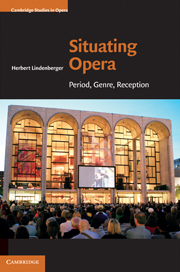Book contents
- Frontmatter
- Contents
- Acknowledgements
- Prologue
- 1 Anatomy of a warhorse: Il trovatore from A to Z
- 2 On opera and society (assuming a relationship)
- 3 Opera and the novel: antithetical or complementary?
- 4 Opera by other means
- 5 Opera and/as lyric
- 6 From separatism to union: aesthetic theorizing from Reynolds to Wagner
- 7 Toward a characterization of modernist opera
- 8 Anti-theatricality in twentieth-century opera
- 9 A brief consumers' history of opera
- Epilogue
- WORKS CITED
- Index
3 - Opera and the novel: antithetical or complementary?
Published online by Cambridge University Press: 05 August 2011
- Frontmatter
- Contents
- Acknowledgements
- Prologue
- 1 Anatomy of a warhorse: Il trovatore from A to Z
- 2 On opera and society (assuming a relationship)
- 3 Opera and the novel: antithetical or complementary?
- 4 Opera by other means
- 5 Opera and/as lyric
- 6 From separatism to union: aesthetic theorizing from Reynolds to Wagner
- 7 Toward a characterization of modernist opera
- 8 Anti-theatricality in twentieth-century opera
- 9 A brief consumers' history of opera
- Epilogue
- WORKS CITED
- Index
Summary
As the common wisdom goes, novel and opera would seem antithetical to one another. For one thing, they are wholly different media: the one a printed form designed for private reading, the other a dramatic representation meant to be performed. The novel is not only consumed privately, but it supposedly focuses upon the private experience of its characters and in turn encourages its readers to reconsider their individual life experiences. By contrast, opera, located as it is in large sonorous spaces, patronized by the so-called beautiful people (whoever they fashion themselves to be at any particular moment of history), and attended by hordes of avid fans relegated to the cheaper parts of the house, can count as the most public and social of art forms.
This appealing model of two media in powerful confrontation with one another served me well when, years ago, I wrote a chapter on the many opera scenes contained within novels for my first book on opera. The scene at the opera, whether centered in social interactions in the lobby or boxes, or in the action onstage, has been an ongoing topos in the novel as a way, one might say, of distinguishing between the ordinariness of the everyday life that is its essential subject matter and the extravagance, as my book's subtitle suggests, of the world of opera.
- Type
- Chapter
- Information
- Situating OperaPeriod, Genre, Reception, pp. 62 - 83Publisher: Cambridge University PressPrint publication year: 2010



